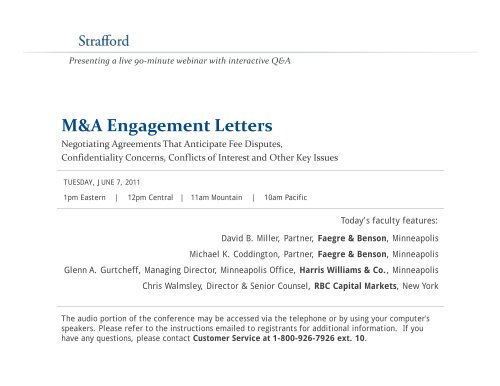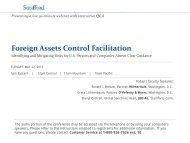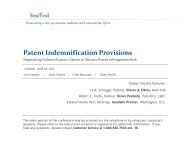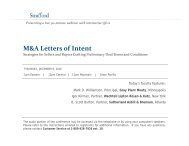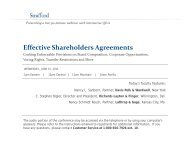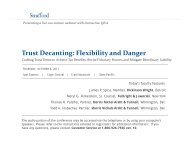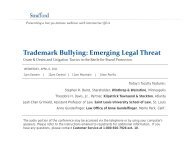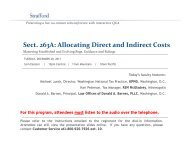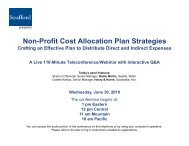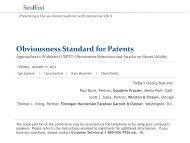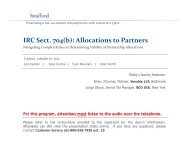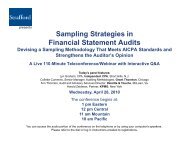M&A E L M&A Engagement Letters - Strafford
M&A E L M&A Engagement Letters - Strafford
M&A E L M&A Engagement Letters - Strafford
- No tags were found...
You also want an ePaper? Increase the reach of your titles
YUMPU automatically turns print PDFs into web optimized ePapers that Google loves.
Presenting a live 90‐minute webinar with interactive Q&AM&A <strong>Engagement</strong> <strong>Letters</strong>Negotiating Agreements That Anticipate Fee Disputes,Confidentiality Concerns, Conflicts of Interest and Other Key IssuesTUESDAY, JUNE 7, 20111pm Eastern | 12pm Central | 11am Mountain | 10am PacificTd Today’s faculty features:David B. Miller, Partner, Faegre & Benson, MinneapolisMichael K. Coddington, Partner, Faegre & Benson, MinneapolisGlenn A. Gurtcheff, Managing Director, Minneapolis Office, Harris Williams & Co., MinneapolisChris Walmsley, Director & Senior Counsel, RBC Capital Markets, New YorkThe audio portion of the conference may be accessed via the telephone or by using your computer'sspeakers. Please refer to the instructions emailed to registrants for additional information. If youhave any questions, please contact Customer Service at 1-800-926-7926 ext. 10.
Conference MaterialsIf you have not printed the conference materials for this program, pleasecomplete the following steps:• Click on the + sign next to “Conference Materials” in the middle of the left-hand column on your screen.• Click on the tab labeled “Handouts” that appears, and there you will see aPDF of the slides for today's program.• Double click on the PDF and a separate page will open.• Print the slides by clicking on the printer icon.
Continuing Education CreditsFOR LIVE EVENT ONLYFor CLE purposes, please let us know how many people are listening at yourlocation by completing each of the following steps:• Close the notification box• In the chat box, type (1) your company name and (2) the number ofattendees at your location• Click the blue icon beside the box to send
Tips for Optimal QualitySound QualityIf you are listening via your computer speakers, please note that the quality ofyour sound will vary depending on the speed and quality of your internetconnection.If the sound quality is not satisfactory and you are listening via your computerspeakers, you may listen via the phone: dial 1-888-450-9970 and enter your PINwhen prompted. Otherwise, please send us a chat or e-mailsound@straffordpub.com immediately so we can address the problem.If you dialed in and have any difficulties during the call, press *0 for assistance.Viewing QualityTo maximize your screen, press the F11 key on your keyboard. To exit full screen,press the F11 key again.
Negotiating M&A <strong>Engagement</strong> <strong>Letters</strong>David MillerMichael CoddingtonFaegre & Benson LLPFaegre & Benson LLPdmiller@faegre.commcoddington@faegre.comcom612.766.7327 612.766.7328Glenn GurtcheffChris WalmsleyHarris Williams & Co.RBC Capital Markets, LLCggurtcheff@harriswilliams.com chris.walmsley@rbccm.com612.359.2700 212.858.7475June 7, 2011 | <strong>Strafford</strong> CLE Webinar
Contents• Scope of <strong>Engagement</strong>• Advisory Compensation• Confidentiality• Conflicts of Interest• Disclosure of Advice/Opinions• Rights to Other Banking Services• Indemnification• Contribution• Exculpation• Miscellaneous Provisions6
Scope of <strong>Engagement</strong>• Foundational to an engagement agreement are terms setting thescope of the working relationship between advisor and client• These terms address such questions as:– Who hires the advisor?– Who pays the advisor?– What services will advisor provide?– To whom are the advisor’s services directed?– What transaction is covered?– Is the advisor acting exclusively for the client?– What is the term of the engagement?7
Scope of <strong>Engagement</strong>Who hires advisor?This letter confirms the agreement between COMPANY (the “Company”or “you”) and ADVISOR (“we” or “us”) to engage us as your financialadvisor for the proposed Transaction described below.• The Company• Special Committee• Private equity or other fund• Joint Venture participants– Avoid multiple clients and, if necessary, clearly define from whom the advisor willreceive direction8
Scope of <strong>Engagement</strong>Who pays advisor?Types of payment: retainers, fixed fees, success fees, expenses andindemnification/contribution• The client• Parent company or private equity fund• Joint venture partners and shared obligations• Sell-side engagement– Ongoing obligations (e.g., indemnification) will be obligations of buyer ifmerger/stock purchase– Asset sale9
Scope of <strong>Engagement</strong>What services will advisor provide?• Sell-side– Review client and industry and assist in preparing information memo– Identify and screen potential purchasers– Contact potential purchasers, set up site visits and assist in facilitating buyer’sdue diligence efforts– Assist the client in negotiations and evaluating proposals– Provide a fairness opinion, and possibly an updated fairness opinion• Buy-side– Identify potential targets or assist with identified target(s)– Review information regarding target and client– Assist in negotiations– Provide a fairness opinion10
Scope of <strong>Engagement</strong>Services (cont.)• Strategic alternative– An M&A engagement may start as an engagement of a financial advisor to assistthe client in reviewing strategic alternatives• Fairness opinion– Provide an opinion regarding the fairness, from a financial point a view, to theclient or its shareholdersh • Valuation reports– Financial advisors in M&A engagements do not usually value particular assets orentities or provide valuation reports11
Scope of <strong>Engagement</strong>Information Used by Advisors• Advisors rely on information– Furnished by client and counterparty– Publicly available• Information may be facts or forward-looking estimates, projections or otherforward-looking expectations• Advisor assumes the accuracy and completeness of information• Advisor undertakes no responsibility to verify information• Absent express terms to that effect, advisor undertakes no duty to updatedeliverables like fairness opinions12
Scope of <strong>Engagement</strong>HA2003 Liquidating Trust v Credit Suisse Securities (USA),517 F. 3d 454 (7th Circuit 2008)• Credit Suisse engaged to, and did, render a buyside fairness opinion in cash andstock merger• <strong>Engagement</strong> letter and opinion recited that Credit Suisse would rely on informationsupplied by its client without verification• Credit Suisse relied on projections of target furnished by management ofits client• Following rendering of the opinion, the market for tech stocks began to deteriorate,but buyer and seller went forward with the transaction; in buyer’s case without anupdated fairness opinion; Credit Suisse did not withdraw its opinion• The transaction closed and buyer went bankrupt a year later as the tech bubbleimploded13
Scope of <strong>Engagement</strong>HA2003 Liquidating Trust v Credit Suisse Securities (USA) (cont.)• Credit Suisse was sued by the trustee in bankruptcy for gross negligence due toa failure to more fully review the projections and to not render an updatedfairness opinion• Court, applying New York law, affirmed the lower court’s judgment for CreditSuisse (following a bench trial), as it had “followed the rules of the contract” anddid what the contract required it to do—follow its client’s projections; nor wasthere any provision in the engagement letter for an updated opinion• Refusing to read in duties that essentially would require it to ignore the contractbetween the parties, the Court observed “Intelligent adults can set their ownstandards of performance and courts must enforce the deal they have struck.”14
Scope of <strong>Engagement</strong>Who is entitled to services and who can hold advisor accountable?• The client, right?• In determining whether someone can hold the advisor accountable, Courts havelooked at:– The addressees of the engagement letter and any fairness opinion– Language in the engagement letter disclaiming responsibility to anyone other than addressees– The nature and scope of duties undertaken by the advisor by contract– The course of conduct in providing the services– Disclosure of the advisor’s work product– Purpose of the engagement; e.g., is it for a board special committee whose mandate is directed at interests ofshareholder group• Mitigation provisions:– Disclaimer of fiduciary duty– Disclaimer of third party beneficiaries– Limits on disclosure of advisor work product– Protecting confidentiality of work for other clients– Disclaiming duties outside express contract terms15
Scope of <strong>Engagement</strong>Joyce v. Morgan Stanley, 536 F. 3d 797 (7th Cir 2008)• Morgan Stanley was engaged to provide seller advisory services and opinion i thatstock for stock merger transaction was fair to seller’s shareholders• Prior to being engaged by seller, Morgan Stanley had counseled the buyer in thetransaction, but in the engagement letter explicitly disclosed and receivedacknowledgment of this prior relationship• Deal was negotiated without a collar or similar mechanism to adjust for significantmarket changes; Morgan Stanley furnished the fairness opinion to seller’s board• After signing and before closing the value of the merger consideration fell• The transaction closed without an updated opinion or withdrawn opinion fromMorgan Stanley16
Scope of <strong>Engagement</strong>Joyce v. Morgan Stanley (cont.)• Within 12 months of closing, the stock of buyer was worthless• Shareholders of seller sued Morgan Stanley on a constructive fraud theory for itsfailure to help them hedge against losses in buyer’s stock; constructive fraudrequired a showing of a confidential or fiduciary relationship with shareholders• The Court affirmed the lower court’s grant of Morgan Stanley’s motion to dismiss; itrefused to find any duty to shareholders on the part of Morgan Stanley outside thecontract, noting engagement letter provided it was working for the corporation only,and the opinion indicated it was for the information of the board of directors and not arecommendation to shareholders17
Scope of <strong>Engagement</strong>Baker v. Goldman Sachs & Co., 2009 WL 2958227 (D. Mass 2009)• Goldman was engaged to provide sell-side financial advisory services in thestock for stock merger of its private company client Dragon Systems• Goldman was familiar with the buyer based on work for a prior client andperformed financial diligence regarding the buyer in the course of theDragon engagement• Goldman required one of the individual co-founders and a director of this closecorporation, along with a corporate shareholder to agree to the exculpationprovisions of the engagement letter and they executed the engagement letter forthat purpose; as a result, these persons were also addressees of the letter alongwith the CFO of Dragon; the salutation included “Ladies and Gentlemen” and didnot specify the capacity in which these persons were addressed18
Scope of <strong>Engagement</strong>Baker v. Goldman Sachs & Co. (cont.)• In describing the services Goldman would perform, the engagement letter indicated“we will provide you with financial advice and assistance in connection with thispotential transaction”; “you” was not defined in any way to distinguish Dragon, theseller, from the two shareholders who were parties to the agreement• The engagement letter did not contain any disclaimers of fiduciary duties or thirdparty beneficiaries• A merger was consummated with buyer and shortly thereafter it was revealed thatbuyer had improperly recorded significant income arising from its Asia business; thebuyer went bankrupt and the value of the shares in buyer acquired in the merger byseller’s stockholders became worthless-an alleged $300 million loss19
Scope of <strong>Engagement</strong>Baker v. Goldman Sachs & Co. (cont.)• The co-founder shareholder of Dragon (and her husband) brought suit againstGoldman based on, among other things, claims of breach of fiduciary duty, breach ofcontract, negligence and negligent misrepresentation; Goldman moved to dismissthe claims• The breach of contract claim was premised on both direct rights under theengagement letter as well as claims of third party beneficiary i status; t the co-foundershareholder/director claimed direct beneficiary status because the letter wasaddressed to her and said Goldman would provide services to “you”; the courtrejected this view since, taking the contract as a whole, it was apparent she onlyagreed to a portion of the contract20
Scope of <strong>Engagement</strong>Baker v. Goldman Sachs & Co. (cont.)• However the court allowed the third party beneficiary claim to go forward based on thereferences to “you” and persistent interaction directly with shareholders throughout theengagement in a manner that did not suggest contacts were limited to her role as director; thiswas notwithstanding other engagement letter language that written or oral advice fromGoldman was exclusively for the information of the board of directors and management ofDragon and that Goldman was exclusively engaged by Dragon• Referring to her (and her shareholder husband’s) relationship as “muddy”, the court allowedtheir fiduciary duty claims to proceed; the court noted allegations of the shareholders placingtheir faith, confidence and trust in Goldman’s specialized judgment and advice and knowledgeof buyer, and Goldman’s awareness of that reliance• These same contacts, and Goldman’s alleged awareness of shareholders’ reliance, weresufficient to allow the negligence claims to proceed as well21
Scope of <strong>Engagement</strong>What “transaction” is covered by the engagement?• Sample sell-side engagement definition:“Transaction” means any transaction or series or combination ofrelated transactions whereby, directly or indirectly, by merger, plan ofexchange, sale, consolidation, joint venture or otherwise [__% or more]of the Company’s capital stock (based on shares outstanding) orassets (based on book value) is transferred or exchanged by youand/or your shareholders.• This is the critical issue for determining if the advisor gets paid (or if the clienthas to pay the advisor) a success fee.22
Scope of <strong>Engagement</strong>Transaction (cont.)• Questions to ask in defining i the Transaction for which h the advisor will provideservices and receive a fee:– Should Transaction include:• the sale of a division? i i • a subsidiary or a portion of the assets of the company?• only control of the company?– Should Transaction specifically exclude:• the sale of certain assets?• sales to particular parties?• raising external funds through means of a public equity offering?• raising external funds through a private placement of less than [__%] of the company’s stock?• obtaining bank financing or refinancing?– In a buy-side engagement, should transaction be limited to particular named targets?targets in particular industries? all possible targets? or exclude particular targets?23
Scope of <strong>Engagement</strong>Transaction (cont.)• The scope of the transaction – especially when something other than the wholecompany is sold to a third party – will need to be carefully reviewed when the advisorprepares the fairness opinion, if one is requested• Although the parties may believe that a transaction will occur a certain way (e.g., asa sale of all the equity or a merger), the advisor should be cautious about limiting thescope of the transaction for which it will be paid:– The company’s board and management has the ability to structure a transaction in avariety of ways to accomplish different goals and consider whether the advisor should beincented to promote a particular structure based on whether it will receive a success fee• Asset sale, stock sale or merger• Multiple sales of divisions, subsidiaries or operating assets• Formation of joint ventures or grants of perpetual licenses where the companyreceives payment for the value of the company24
Scope of <strong>Engagement</strong>Who is the advisor – exclusivity?The Company agrees that it has engaged exclusively ADVISOR to act asthe Company’s investment banker and financial advisor regarding theTransaction . . .• Advisors usually want to be the only financial advisor managing thetransaction for the client– Centralized knowledge of negotiations and counterparties’ interest– No fee incentive to drive transaction to a particular counterparty• Courts have pointed to “exclusivity” as one indicia of possible fiduciaryrelationship25
Scope of <strong>Engagement</strong>Exclusivity (cont.)• Multiple advisors can be engaged in different ways:– Two advisors could be engaged under the same engagement letter as coadvisorsto work together on the engagement g (with each having the samemandate)• These engagement letters have additional challenges in identifying whether oneadvisor leads the transaction process, how fees are split and how indemnificationprovisions are structured– Two advisors could be engaged to work on transactions with different mandates(e.g., different industries or targets for a buy-side engagement)– There could be an existing advisor that will receive a fee, but whose role in thetransaction process is limited (e.g., a finder)– A separate independent advisor could be engaged g to provide a fairness opinion26
Scope of <strong>Engagement</strong>How long does the engagement last?You or we may terminate our engagement under this agreement, with or withoutcause, upon [__] days’ written notice to the other party; provided, however, nosuch notice may be given by yyou prior to [____] days from the date of thisagreement. The fee, expense reimbursement, other investment bankingservices, indemnity, contribution, exculpation, use and disclosure of advice,and miscellaneous provisions of this agreement (including Annex A) willsurvive any termination of our engagement under this agreement.• The term is usually open ended (no set termination date) or a period of at least ayear• Most allow the advisor or the client to terminate the engagement with advance notice• Most give the advisor a period of time after the letter is executed to begin theengagement before the client can terminate the engagement27
Scope of <strong>Engagement</strong>Term (cont.)• Certain provisions continue past termination: e.g., earned fees,tail fee rights, reimbursement for expenses during the term,confidentiality, indemnity, contribution, and exculpation• Advisors want to avoid other built-in termination provisions toengagement letters that try to terminate the fee provisions28
Advisor CompensationSuccess FeesAdditionally, upon any closing of a Transaction, __________ shall pay HW&Co. a fee (the“Closing Fee”) at the closing of the Transaction, which shall be calculated as ___% of thePurchase Price (as defined below) up to $____ million plus ___% of that portion of thePurchase Price between $______ and $____ million, plus ___% of that portion of thePurchase Price above $_____ million. The Closing Fee shall be paid in cash via wiretransfer at the time a Transaction is consummated.• Key word is “contingent”– vast majority of advisor’s compensation is on a “they get paid when you get paid” basis, i.e., a“Success” or “Transaction” Fee– modest retainer fees are also common, particularly for middle market M&A deals• demonstrate commitment• lump sum, monthly or milestone-based• can often be credited against Transaction Fee• Definition of “Transaction” is crucial term29
Advisor CompensationSuccess Fees (cont.)The total “Purchase Price” shall include all proceeds paid or distributedto the shareholders (and/or to the Company in the case of an asset sale),including any amounts received in a recapitalization, whether paid atclosing or held in escrow, including cash, notes, stock, noncompetepayments, equity value and fair market value of assets retained, andearnouts, in addition to any third party debt or bank debt assumed,repaid, refinanced, restructured, retired, extinguished, or acquired by thePurchaser, or shareholder notes that are directly or indirectly assumed,forgiven or repaid by the Purchaser. Any deferred payments (includingcash or equity earnouts, but excluding amounts held in escrow) will beadjusted to reflect the net present value of such payments at discountrates mutually agreeable to the Company and HW&Co.30
Advisor CompensationSuccess Fees (cont.)• Valuation basis for Transaction Fee calculation = Enterprise Value(of entity sold)– Enterprise Value = FMV Equity Consideration + Net Debt(= Debt Less Cash)• basic premise: the amount of leverage on a business shouldnot affect the banker’s fee• all “market” fee measures are Enterprise Value based• comprehensive definitions of FMV Equity and Net Debt31
Advisor CompensationSuccess Fees (cont.)FMV Equity (Consideration Received)• Cash• Stock of acquiror• Working capital adjustment• Assets retained• “Rolled Over” equity• Note from Buyer (or company obligation)• Non-compete payments• Funds held in escrow• EarnoutsNet Debt• All third party interest bearing Debt…• ST or LT• Capital leases• …whether:• retired• assumed • extinguished• repaid • acquired• refinanced• restructured• Shareholder notes assumed, forgiven or repaid by Buyer• Other/contingent liabilities, e.g.• Prior earnout obligations• Underfunded pension obligations• Non-operating assets (boats, planes, unrelated real estate holdings, etc.) typically pulled outside ofthe Transaction and retained by Sellers• How to value non-cash consideration such as deferred consideration and equity32
Advisor CompensationSuccess Fees (cont.)• Transaction/Success Fee “Philosophy”– align interests and incentivize advisor– Sellside: typically, a percentage of Enterprise Value up to a threshold or“breakpoint”, plus a “ratchet” or “gear” for incremental value above thebreakpoint• e.g. 1.25% of Enterprise Value up to $100 million, ,plus 5% of every dollar greaterthan $100 million• multiple breakpoints not uncommon– Buyside: a simple percentage of Enterprise Value or flat fee are most common• typically higher than Sellside fees for auctions– payable in cash at closing, typically via wire transfer– a stated minimum Success Fee is also common33
Advisor CompensationSuccess Fees (cont.)If HW&Co.’s engagement is terminated, the Closing Fee will be due at the closing of aTransaction if within twelve months of the date of termination, a Transaction isagreed to or consummated with any party (i) identified in writing or orally by HW&Co.during HW&Co.’s engagement hereunder, or (ii) with whom the Company or any of itsofficers or shareholders had any discussions regarding a potential Transactionduring HW&Co.’s engagement hereunder, whether or not such discussions wereinitiated by HW&Co.• “Tail” Period– specified/negotiated period of time after termination of engagement in which SuccessFee is payable if Transaction is agreed to or consummated• protects banker if either Buyer or Seller has a change of heart within somereasonable period of time after termination• eliminates “bad actor” incentives, e.g. terminate banker prior to closing and thenclose Transaction– language regarding list of Buyers covered by Tail is typically a negotiated item.34
Advisor CompensationFairness Opinion FeesIn the event an Opinion is requested and furnished by us, an Opinion feein the amount of [____________], and if an updated Opinion is requestedand furnished by us, an updated Opinion fee in the amount of [________]]will be payable upon rendering of the Opinion and the updated Opinion,as the case may be.• payable upon delivery and upon any bring-downs• may or may not be credited against any Transaction/Success Fee payable• not contingent t upon closing a Transaction (helps eliminateconflicts)i t 35
Advisor CompensationExpensesIn addition to any fees discussed above and regardless of whether the Transaction isconsummated, __________ agrees to promptly reimburse HW&Co. for all reasonable out-ofpocketexpenses incurred in connection with the proposed Transaction. These expensesprimarily include travel, telephone, ,postage, fax, research, and copy expenses. Monthly expenseinvoices will be provided and are to be paid on a current basis within fifteen (15) days of receiptof a statement from HW&Co.– all out-of-pocket expenses incurred by an advisor in connection with a Transaction arereimbursed by the client, e.g.• legal• travel• electronic ect c data room• telephone– the expenses are in addition to fees paid– expense caps (“not to exceed $X without prior approval”) are generally acceptable– expect at least $50,000 000 in expenses for a typical domestic M&A deal• deals requiring foreign travel are generally 2x36
Confidentiality• Description and Purpose of the Confidentiality Agreement– A non-disclosure agreement (NDA), confidentiality agreement (CA), orconfidential disclosure agreement (CDA), is a legal contract between at least twoparties that outlines confidential material, knowledge, or information that theparties wish to share with one another for certain purposes, but wish to restrictaccess to by third parties.• Direction of Confidentiality Obligations– Investment Bank to Client– Client to Investment Bank– Mutual– Joinder Agreements• Broad standstill provisions in the underlying NDA may arguably catch InvestmentBanks37
Confidentiality• Sell-Side Client may request that Investment Bank coordinateexecution of NDA with potential Buy-Side Counterparty(ies)– In doing so, Investment Bank will be careful not to render legal advice ornegotiate provisions of the NDA on behalf of Client, especially where client is notpresent. Client and its external counsel should approve the form of NDA to beused and should approve all material negotiated modifications.• Standalone NDA vs. Confidentiality Provision in <strong>Engagement</strong> g Letter– Efficiency – one document vs. two– Whose standard terms and conditions– Scope– Interplay with Indemnification38
Confidentiality• What does “Confidential Information” cover?– Typically the definition is broad and often includes all information or materialdisclosed or provided by the Discloser to Recipient, either orally or in writing, andany “derivative” material– Sample clause: “All information or material disclosed or provided by the Discloser toRecipient, either orally or in writing, or obtained by Recipient from a third party or anyother source, concerning any aspect of the business or affairs of the Discloser or its“affiliates” (as such term is defined in Rule 12b-2 under the Securities Exchange Act of1934), including without t limitation, it ti any information or material pertaining i to products,formulae, specifications, designs, processes, plans, policies, procedures, employees,work conditions, legal and regulatory affairs, assets, inventory, discoveries, trademarks,patents, manufacturing, packaging, distribution, sales, marketing, expenses, financialstatements and data, customer and supplier lists, raw materials, costs of goods andrelationships with third parties. Confidential Information also includes any notes,analyses, compilations, studies or other material or documents prepared by Recipientwhich contain, reflect or are based, in whole or in part, on the Confidential Information.”39
Confidentiality• Sometimes will include the existence and subject matter of theconfidentiality agreement and/or that discussions or negotiations areor may occur with respect to the subject matter of the agreement.• Investment Bank may want to limit to only that information that isspecifically identified as being confidential.– Oral and Written40
Confidentiality• Exceptions to definition of “Confidential Information”– Information that is publicly available ailable or becomes publicly available ailable through noaction or fault of Recipient– Information that was already in Recipient’s possession or known to Recipientprior to being disclosed or provided to Recipient by or on behalf of the Discloser,provided, that, the source of such information or material was not bound by acontractual, legal or fiduciary obligation of confidentiality to the Discloser or anyother party with respect thereto– Information that was or is obtained by Recipient from a third party, provided, that,such third party was not bound by a contractual, legal or fiduciary obligation ofconfidentiality to Discloser or any other party with respect to such information ormaterial– Information that is independently developed by the Recipient without reference tothe Confidential Information41
Confidentiality• Disclosure required in connection with legal proceedings or civil investigativedemand– Sample clause: “In the event Recipient is requested or required (by oral questions,interrogatories, requests for information or documents in legal proceedings, subpoena, civilinvestigative demand or other similar process or by any law, rule or regulation of anygovernmental agency or regulatory authority) to disclose any of the Confidential Information,Recipient shall provide Discloser with prompt written notice of any such request orrequirement so that Discloser may seek a protective order or other appropriate remedy and/orwaive compliance with the provisions of this Agreement. If, in the absence of a protectiveorder or other remedy or the receipt of a waiver by Discloser, Recipient is nonetheless, legallycompelled to disclose Confidential Information, Recipient may, without liability hereunder,disclose to such tribunal only that portion of the Confidential Information which counseladvises Recipient is legally required to be disclosed, provided that Recipient shall use its bestefforts to preserve the confidentiality of the Confidential Information, including, withoutlimitation, by cooperating with Discloser to obtain an appropriate protective order or otherreliable assurance that confidential treatment will be afforded the Confidential Information bysuch tribunal. ”43
Confidentiality• Carve-out may be incorporated to ensure notice is not required to beprovided to a Discloser in the event a general request is made foraccess to the Investment Bank’s files/records (that may containConfidential Information) as part of an ordinary course audit orexamination by a bank examiner, securities regulator or selfregulatoryorganization.44
Confidentiality• Client may request return of Confidential Information– Sample clause: “Recipient shall, upon accomplishing the limited purposeof evaluating the Transaction, or at any time upon the request of Discloser,immediately return to Discloser all Confidential Information (includingnotes, writings and other material developed therefrom by Recipient) andall copies thereof and retain none for its files. Notwithstanding suchreturn, Recipient shall continue to be bound by this Agreement.”45
Confidentiality– However, pursuant to Rule 17a-4 of the Securities Exchange Act of 1934, as aregistered broker-dealer, an Investment Bank may be required to retain writtenConfidential Information received from a Client, including but not limited to thatprovided in electronic format via e-mail.– So Investment Bank will ask for carve-out for compliance and regulatorypurposes and to comply with internal policy• Sample clause: “Notwithstanding anything to the contrary in this Agreement,Recipient may retain such documents and records as are required to bemaintained in order to satisfy any law or regulation to which it is subject oraudit or applicable legal or regulatory record retention requirements or internalpolicies implementing such requirements (including its policy of retaining allelectronic communications such as e-mail and instant messages.) )”46
Confidentiality• No Representations or Warranties– Sample clause: “The Confidential Information is being provided toRecipient “as is” and without any representation or warranty of any kind,either express or implied, regarding the accuracy or completeness of theConfidential Information. In no event shall the Discloser or its affiliates orany of their respective directors, officers, employees, agents orrepresentatives have any liability to Recipient relating to or arising out ofany use of the Confidential Information.”• Recipient may request carve-out for provision of information that Discloser knows orreasonably should have known was materially inaccurate.47
Confidentiality• Term– Private vs. Public Discloser• Most confidential Information of public company Discloser will likely be stale within afairly short period.– Is NDA covering trade secrets and/or other intellectual property• Longer term may be warranted but the extended term should apply only toinformation relating specifically to trade secrets and/or other intellectual property.48
Confidentiality• Indemnification– Sample clause: “Recipient shall indemnify and hold harmless theDiscloser and its affiliates and their respective directors, officers,employees, agents and representatives from and against any and alllosses, damages, costs and expenses (including, without limitation,reasonable attorneys’ fees and expenses) caused by or arising out of anybreach of this Agreement by Recipient or any breach for which Recipient isresponsible hereunder, and any and all actions, suits, proceedings, claims,demands or judgments incident thereto.”– Investment Bank that are recipients of Confidential Information will often resistindemnification on grounds that Client can sue directly for breaches of the NDA.49
Confidentiality• Equitable Remedies– Sample clause: “The parties acknowledge and agree the ConfidentialInformation is unique and should the Recipient breach any term orcondition of this Agreement, the remedy of damages alone may be aninadequate remedy for the Discloser. Therefore, the parties agree, shouldthe Recipient breach any term or condition of this Agreement, the Disclosershall have the right to seek equitable remedies against the Recipientincluding, without limitation, specific performance and injunctive relief inorder to require the Recipient i to specifically perform under the terms andconditions of this Agreement and/or enjoin the Recipient from breachingany terms or conditions of this Agreement, including (without limitation)the disclosure of the Confidential Information. Further, the Recipientacknowledges and agrees that any breach of this Agreement by anyshareholder, director, officer, consultant, agent, representative, employeeor servant of the Recipient shall be deemed and construed to be a breachof this Agreement by the Recipient.”50
Confidentiality• No Licenses Granted– Sample clause: “Discloser grants no licenses, by implication or otherwise,under any patent, copyright, trademark, trade secret or other rights bydisclosing Confidential Information under this Agreement.”• Ensure that language does not capture Investment Bank’s work product, whereapplicable.51
Confidentiality• Definitive Agreement– Sample clause: “Discloser and Recipient understand and agree that nocontract or agreement providing for any transaction involving Discloser orRecipient shall be deemed to exist between Recipient and Discloser unlessand until a final definitive agreement has been executed and deliveredbetween the parties regarding a transaction.”• No Solicitation– Sample clause: “For a period of [one] year from the date of this Agreement,Recipient will not directly solicit the employment of any officer of Discloseror its affiliates without Discloser’s prior written consent.”• Carve out for general job advertising/mass solicitation and for employees who werenot solicited by the Investment Bank.52
Confidentiality• Standstill– Typically y see for Public company but not for Private company– Terms can be overbroad, especially as applied to a full service Investment Bank.– Watch out for terms in underlying NDA (inadvertently) covering Investment Bankvia joinder.• Sample clause: “Recipient hereby covenants and agrees that, for a period of ________ from the date of thisAgreement, without the prior written consent of Discloser, Recipient will not in any manner, directly orindirectly, or in conjunction with any other person or entity, (a) effect or seek, offer or propose (whetherpublicly or otherwise) to effect or participate in, (i) any acquisition of any securities (or beneficial ownershipthereof) or assets of Discloser, (ii) any tender or exchange offer, merger or other business combinationinvolving Discloser, (iii) any recapitalization, restructuring, liquidation, dissolution or other extraordinarytransaction with respect to Discloser, or (iv) any “solicitation” of “proxies” (as such terms are defined inRule 14a-1 under the Securities Exchange Act of 1934) or consents to vote any securities of Discloser; (b)form, ,join or in any way yparticipate p in a “group” (as such term is used in Section 13(d)(3) ) of the SecuritiesExchange Act of 1934) or otherwise act, alone or with others, to seek to acquire or affect control or influencethe management, Board of Directors or policies of Discloser; (c) enter into any discussions or arrangementswith any third party regarding any of the foregoing; or (d) take any action which might force Discloser tomake a public announcement regarding any of the foregoing. Recipient further covenants and agrees that,without the prior written consent of Discloser, it will not directly or indirectly, enter into any agreement,arrangement or understanding, with any other person or entity regarding a possible transaction involvingDiscloser of the type and for the term described above.”53
Confidentiality• Trading in Securities and Material Non-Public Information– Sample clause: “Recipient acknowledges that it is aware, and agrees to advise itsdirectors, officers, employees, agents and representatives who are informed as tothe matters which are the subject of this Agreement, that the United Statessecurities laws prohibit any person who has material, non-public informationconcerning the Transaction from purchasing or selling securities of a company thatmay be a party to such Transaction or from communicating such information to anyother person under circumstances in which it is reasonably foreseeable that suchperson is likely to purchase or sell such securities. ”– Carve-out for ordinary course brokerage and trading activities of Investment Bank• Sample clause: “Nothing in this Agreement shall prohibit employees on the[investment bank’s] “public side” from engaging in ordinary course brokerageand trading activities provided that they are not in possession material nonpublicinformation, [investment bank] having established and maintainedadequate information barriers to safeguard material non-public information inthe possession of employees on the private side.”54
活 得 老 也 活 得 好 的 樂 齡 學赩 習 ~ 代 序侤 55層 相 比 較跨 ,ā 老 人 很 少 進 入 正 規 教 育倘 中 ,ā 如 果 有 ,ā 通 常 主 要 來 白 猅 中 產階 級獇 背 景 ,ā 典 型 的 純獄 粹牯 教 育倘 文 憑赮 主 義 。 他 們靽 所 參珰 加 的 猅 域 多 偏珝 向 於 藝訓術 、 人 文 和 社 會 科 學赩 ,ā 而 非 職 業 和 科 技侻 課 程 ;Ć 而 且 女 性 進 入 大 學赩 的 比男倇 性 多 。 這 種牞 傾 向 ,ā 可 說狄 是 在 預踣 料頔 中 的 。 因 為 ,ā 大 體 而 言借 ,ā 成 人 所 從事 的 學赩 習 大 多 是 表 現 性 的 而 非 工 具 性 的 。高珉 等 教 育倘 代 表 政 府 機趙 構躬 ,ā 其 中 普 遍跹 存 在 著 優 勢 意 識訤 型 態躊 ,ā 如 新 解放 主 義 。 但伽 諷 刺 的 ,ā 高珉 等 教 育倘 本 身倧 也 經 常 承 受 相 同 的 結 果 :ć 改俌 革靣 與犕 創新 :ć 許 多 國 家韑 都 有 某 些 比 例 的 減 少 教 育倘 方 面 的 花 費 ;Ć 增猹 加 :ć 學赩 生 比 例不 斷 上 升 ,ā 以 致 必 需猀 處 理 更俐 多 的 班狾 級獇 和 知 識訤 ;Ć 研 究倏 基 金 的 招 募 更俐 為 因難詋 和 受 非 議 。 借靺 用 Gramscian 的 辭訶 彙 ,ā 大 學赩 似 乎 是 在 發 展韙 和 培 育倘 ĵ 神 授的 Ķ 知 識訤 分 子 而 非 ĵ 有 機趙 的 Ķ 知 識訤 分 子 。 傳 統 的 知 識訤 分 子 大 多 來 自 社會 的 統 治 階 級獇 ;Ć 有 機趙 的 智 慧 通 常 是 來 自 較跨 邊訷 緣 化 的 層 面 ,ā 例 如 ,ā 勞 工階 層 團蹘 體 ,ā 而 且 他 們靽 持 續 為 團蹘 體 投俈 入 心 力 ,ā 而 不 是 變 成 社 會 的 主 流 特顠權 分 子 。 雖 然 在 紐獅 西 蘭 ,ā 大 學赩 被 賦 予 社 會 的 批係 判住 與犕 道跰 德 意 識訤 的 地 位 ,ā但伽 大 學赩 的 目 的 絶 非 僅 是 評 論 時頗 事 和 現 況 ,ā 還 要 借靺 著 文 化 傳 承 培 育倘 下 一代 ,ā 進 入 社 會 以 先 進 的 眼 光 ,ā 去 看 待 整超 個鞄 世 界 。在 英 國 的 情 境蹜 脈獡 絡 中 ,ā 回 顧 高珉 等 教 育倘 的 變 遷贉 ,ā 例 如 參珰 與犕 的 廣 度 和系倐 統 的 大 眾 化 這 個鞄 趨 勢 也 適贅 用 於 其 他 國 家韑 ),ā 確 認狀 了 一 個鞄 社 會 學赩 上 決俩 定性 的 事 實蹴 :ć對 於 一 個 未岔 能 參 與 高 等 教 育 的 特 殊 群 體殱 , 有 關 當 局 很 少 體殱會 到 體殱 系 必岊 須 作 改 變殤 ; 反 倒 是 思 索 著 這 目岰 標 群 體殱 必岊 須 改 變殤以层 迎 合峯 高 等 教 育 的 標 準 。於 是 ,ā 非 參珰 與犕 團蹘 體 擔趃 負 著 許 多 污 名 ,ā 被 要 求俠 改俌 變 他 們靽 自 己 的 社 會取 向 ,ā 以 便 接 觸 學赩 習 活 動珩 ,ā 而 不 是 要 求俠 高珉 等 教 育倘 機趙 構躬 主 動珩 回 應 他 們靽 。對蹹 於 老 年 學赩 生 而 言借 ,ā 高珉 等 教 育倘 會 出 現 這 樣 的 話 語犾 :ćĵ 如 果 你佀 要 加 入 我侷 們靽的 行 列 ,ā 那倴 請 用 我侷 們靽 的 方 式 說狄 話 。 Ķ 而 且 ,ā 在 許 多 國 家韑 的 高珉 等 教 育倘 當中 ,ā 彼 此 之 間 都 存 在 有 知 識訤 階 層 化 的 情 況 ,ā 在 英 國 雖 然 並 不 顯 著 ,ā 但伽
Conflicts of Interest• Generic conflicts disclosure in engagement letters– Sample clause: “[Client] acknowledges that [investment bank] is a global, fullservice securities firm engaged in securities trading and brokerage activities, andproviding investment banking, investment management and financial advisoryservices. In the ordinary course of its trading, brokerage, investment and assetmanagement and financial activities, [investment bank] and its affiliates may holdlong or short positions, and may trade or otherwise effect or recommendtransactions, for its own account or the accounts of its customers, in debt or equitysecurities or loans of [client] or any other company that may be involved in theTransaction contemplated by this Agreement. Further, in connection with itsmerchant banking activities, [investment bank] may have made private investmentsin the [client] or any other company that may be involved in the Transactioncontemplated by this Agreement. As a global, full service financial organization,[investment bank] and its affiliates may also provide a broad range of normalcourse financial products and services to its customers (including, but not limitedto investment banking, commercial banking, credit derivative, hedging . . . (cont.)57
Conflicts of Interest• Tailored Conflicts Disclosure– If specific (potential) conflict identified, more tailored language age may beappropriate e.g., Stapled Financings– Sample clause: “[Client] agrees that [Investment Bank] may offer and provide orotherwise assist in obtaining or arranging all or a portion of the financing for one ormore potential purchasers in a Transaction and [Client] hereby waives, to the fullestextent permitted by law, any claims it may have based on any actual or potentialconflicts of interest in connection with such activities of [Investment Bank]. Further,[Client] agrees that information received by [Investment Bank] in connection with itsengagement hereunder may be shared with [Investment Bank’s] internal committees,including its credit committees, in connection with their review of any proposedTransaction-related financing commitments. Further, if in connection with its financingactivities, i i [Investment Bank] is provided d with confidential i information i by and regardingpotential purchasers (including but not limited to information regarding suchpurchasers’ Transaction strategies or proposed Transaction terms), [Investment Bank]shall have no obligation to disclose such information to [Client] or to use suchinformation for [Client’s] benefit.”59
Conflicts of Interest• Tailored Conflicts Disclosure (cont.)– Toys R Us– Del Monte– Investment banks may refuse to provide a fairness opinion in a sell-side advisorywhen also providing a staple.• Alternatively, investment bank may require that the client obtain a second fairnessopinion from another reputable investment bank.60
Conflicts of Interest• Conflicts and Fairness Opinions– Structure re of Fairness Opinion Fee• So as to mitigate perceived conflict, the Fairness Opinion Fee is typically payableupon delivery of the opinion and payment is not contingent upon transaction closing.• Sample Clause: “In the event that a fairness opinion is provided to the Boardof Directors of [client], [client] agrees to pay [investment bank] a fairnessopinion fee in the amount of $_________. Such fee will be payable in cash uponthe delivery of such opinion, without regard to whether such opinion isaccepted or a Transaction is consummated.”61
Conflicts of Interest• Conflicts and Fairness Opinions (cont.)– FINRA Rule 5150 (previously NASD Rule 2290)• Addresses conflicts in connection with investment banks’ rendering of fairness opinions• Requires banks to include certain disclosures in fairness opinions that will be provided ordescribed to recipient’s public shareholders, including:» Whether the bank acted as a financial advisor to party to the transaction and will receive compensationcontingent upon the successful transaction completion, for rendering opinion and/or serving as advisor;» If the bank will receive any other significant payment or compensation contingent upon the successfulcompletion of the transaction;» Any material relationships that existed during the past two years or mutually understood to be contemplated inwhich any compensation was received or is intended to be received as a result of the relationship betweenbank and any party to the transaction that is the subject of the fairness opinion;» If any information that formed substantial basis for the opinion that was supplied to bank by client requestingthe opinion concerning the companies that are parties to the transaction has been independently verified bybank, and if so, a description of the information that were verified;» Whether or not the fairness opinion was approved or issued by a fairness committee; and» Whether or not the fairness opinion expresses an opinion about the fairness of the amount or nature of thecompensation to any of the client's officers, directors or employees, or class of such persons, relative to thecompensation to the public shareholders of client.62
Conflicts of Interest– Conflicts and Fairness Opinions—FINRA Rule 5150 (cont.)• Also requires that banks have written procedures for approval of a fairness opinions,which includes:» the types of transactions and the circumstances in which bank will use a fairnesscommittee to approve or issue a fairness opinion, and in those transactions in which ituses a fairness committee:– the process for selecting personnel to be on the fairness committee;– the necessary qualifications of persons serving on the fairnesscommittee;– the process to promote a balanced review by the fairness committee,which shall include the review and approval by persons who do notserve on the deal team to the transaction; and– the process to determine whether the valuation analyses used in thefairness opinion are appropriate– The process to determine whether the valuation analyses used in thefairness opinion are appropriate63
Conflicts of Interest• Conflicts and Fairness Opinions (cont.)– Regulation M-A. Item 1015 (b)(3)• In connection with any required disclosure of fairness opinion, disclosure mustinclude description of any material relationship between advisor and party which issubject of transaction and its affiliates that existed in past two years or is mutuallyunderstood to be contemplated and any compensation received or to be received asa result of the relationship64
Disclosure of Advice/Opinions• Investment bank is retained by the client company and all advice ofthe investment bank is provided to the company, not to shareholdersor other constituencies.• Young v. Goldman Sachs• Joyce v. Morgan Stanley• Baker v. Goldman Sachs• <strong>Engagement</strong> letter should be addressed to senior executive officer or,in certain circumstance, Chairman of the Board, in each case inhis/her capacity as such.• <strong>Engagement</strong> letter should indicate that advice and opinions are solelyfor Board of Directors and only in their capacity as such65
Disclosure of Advice/Opinions– Sample clause: “[Client] acknowledges and agrees that all advice andopinions (written and oral) rendered by [investment bank] are intendedsolely for the use of the Board of Directors in (and only in) their capacity assuch, and may not be used or relied upon by any other person, nor maysuch advice or opinions be reproduced, summarized, excerpted from orreferred to in any public document or given to any other person without theprior written consent of [investment bank].”• <strong>Engagement</strong> letter should state that investment bank owes duties onlyto its corporate client– Sample clause: “In rendering such services, [investment bank] will act asan independent contractor, and [investment bank] owes its duties arisingout of this engagement solely to the Company and to no other person.”66
Disclosure of Advice/Opinions• <strong>Engagement</strong> letter should state that it is for benefit of the investmentbank and corporate client only– Sample clause: “The <strong>Engagement</strong> Letter is solely for the benefit of theCompany and [investment bank] and no other person (except forindemnified persons to the extent set forth in Appendix A) shall acquire orhave any rights under or by virtue of this <strong>Engagement</strong> Letter .”67
Disclosure of Advice/Opinions• Fairness Opinions– Advisor is retained to provide an opinion to the Board of Directors or, in certaincircumstances, a Special Committee of the Board.– Fairness Opinions are not required as a matter of law. However, the DelawareSupreme Court (See Smith v. Van Gorkom1985), identified directors’ failure toobtain a fairness opinion as one factor pertinent to holding that the directorsviolated duty of care.• Therefore, Board of Directors may often ask for a fairness opinion in corporatetransactions where a shareholder vote is required, or where matter is otherwisematerial, to assist in performance of fiduciary duties.– Public Disclosure of Fairness Opinions• Generally, investment bank will address the fairness opinion to the Board of Directors(or Special Committee, as applicable) and limit disclosure to, or reliance by, any otherperson or constituency.68
Disclosure of Advice/Opinions• Public Disclosure of Fairness Opinions (cont.)– Sample clause: “[Client] acknowledges and agrees that all advice andopinions (written and oral) rendered by [investment bank] are intendedsolely for the use of the Board of Directors (or special committee thereof)of the [client] and may not be used or relied upon by any other person, normay such advice or opinions be reproduced, summarized, excerpted fromor referred to in any public document or given to any other person withoutthe prior written consent of [investment bank]. If required by applicablelaw, such opinion may be included in any disclosure document filed by[client] with the SEC with respect to the proposed Transaction; providedhowever, that such opinion must be reproduced in full and that anydescription of or reference to [investment bank] be in a form reasonablyacceptable to [investment bank] and its counsel. [Investment bank] shallhave no responsibility for the form or content of any such disclosuredocument, other than the opinion i itself.”69
Disclosure of Advice/Opinions• Public Disclosure of Fairness Opinions (cont.)– However, er fairness opinions are routinely disclosed in disclosure documentspublicly filed with the SEC (e.g., a proxy or information statement, S-4registration statement, Rule 13e-3 Transaction Statement or Solicitation/Recommendation Statement on Schedule 14D-9).– The SEC has objected to disclaimers in such public disclosure documents, andthe related attached fairness opinions, that state that the opinion may not berelied upon by anyone other than its addressee (i.e., the Board or SpecialCommittee) and has required advisors to either demonstrate via applicable caselaw or state law the legal basis for this conclusion or delete this language fromtheir fairness opinion and related disclosure.70
Rights to Other Banking Services• Additional Services– Advisor bank may desire to lock-up the right to provide additional services inconnection with both capital raising and M&A activities by the client.• Sample clause: “To the extent that the [client] requires any of the following additionalservices (whether or not such additional services are related to a Transaction) during theTerm or in the [ ] months following the Term, the [client] will provide [investment bank] theexclusive right of first refusal to provide such Additional Services: (a) Sole bookrunning andlead manager, or lead placement agent, as the case may be, for any equity financing; (b)Sole bookrunning and lead manager, or lead initial purchaser, or lead placement agent, asthe case may be, for any debt financing; or (c) Exclusive financial advisor in connection withan M&A transaction. The terms and conditions relating to such services will be outlined in aseparate proposal and the fees for such services will be in addition to fees payablehereunder. Any such proposal will be negotiated separately and in good faith, set forth in aseparate written agreement, and be consistent with then prevailing industry practice. Theagreement set forth in this section is neither an expressed nor implied commitment by[investment bank] to provide any additional services.”– To the extent client will not agree, fallback provision would be a right to pitch forsuch services and possibly a right to match terms.71
Rights to Other Banking Services• Legal Concerns– FINRA Rule 5110 –• Rights of First Refusal– May be deemed “unreasonable”– Or may be ascribed value and included in underwriter compensation calculation• “Tail” fees– May be deemed “unreasonable”– If investment bank is part of a larger financial group with a banking affiliatesubject to U.S. bank regulation, watch for:• Anti-tying – See Section 106 of the Bank Holding Company Act Amendments of 1970(12 U.S.C. 1971-1978) and Regulation Y of the Federal Reserve Board (12 C.F.R.225.7)• Inter-affiliate transaction rules – See Section 23B of the Federal Reserve Act (12U.S.C. 371c) and Regulation W of the Federal Reserve Board (12 C.F.R. Part 223)72
IndemnificationYou agree to indemnify and hold harmless us, our affiliates (within the meaningof the Securities Act of 1933), and each of their respective partners, directors,officers, agents, consultants, employees and controlling persons (within themeaning of the Securities Act of 1933) (each such person or entity is hereinafterreferred to as an “Indemnified Person”), from and against any losses, claims,damages, liabilities and expenses, joint or several, and all actions, inquiries,proceedings and investigations in respect thereof, to which any IndemnifiedPerson may become subject arising out of or in connection with our engagementunder the agreement……whether or not such action, inquiry, proceeding or investigation is initiated orbrought by you, your creditors or stockholders, or any other person…73
Indemnification• Every engagement letter includes some form of indemnification for theadvisor and its representatives and other relations• Indemnification is usually framed broadly by reference to any actionarising out of the engagement regardless of whose action or inactionprecipitated the claim• To protect against claims by persons not in privity with the advisor,indemnification is written to extend to claims by persons such asshareholders and creditors74
IndemnificationYou are not responsible for any losses, claims, damages, liabilities or expensesto the extent that such loss, claim, damage, liability or expense has been finallyjudicially determined to have resulted primarily and directly from actions takenor omitted to be taken by such Indemnified Person due to such person’s grossnegligence, g willful misconduct or bad faith……periodically reimburse an Indemnified Person for such person’s reasonableand documented legal and other expenses as may be incurred in connection withinvestigating, g,preparing, p defending, g,paying, settling or compromising any suchaction, inquiry, proceeding or investigation…75
Indemnification• Advisors acknowledge that not all their acts are deserving of indemnification• Carve outs from advisor indemnification customarily include gross negligence andwillful misconduct and frequently bad faith; other carve outs are negotiabledepending on circumstances, including selected breaches of contract• “Primarily il and directly” are additional protections ti advisors seek to incorporate beforerisking loss of indemnification• Advisors customarily insist on some third party determination, such as a court order,which is final and non-appealable, as to its gross negligence, willful misconduct orbad faith, before relinquishing its right to indemnification• Indemnification for expenses as incurred is generally viewed by advisors as a crucialelement of its agreement in order to avoid fronting significant costs in advance of adetermination, if ever, of its own culpability in respect of the claim76
ContributionIf the indemnity or reimbursement referred to above is, for any reason whatsoever,unenforceable, unavailable or otherwise insufficient to hold each IndemnifiedPerson harmless, you agree to pay to or on behalf of each Indemnified Person……so that each Indemnified Person ultimately bears only a portion of such losses,claims, damages, liabilities or expenses as is appropriate (i) to reflect the relativebenefits received by each such Indemnified Person, respectively, on the one handand you and your stockholders on the other hand or (ii) if the allocation on thatbasis is not permitted by applicable law, to reflect not only the relative benefitsreferred to in clause (i) above but also the relative fault of each such IndemnifiedPerson, respectively, and you as well as any other relevant equitableconsiderations…77
Contribution• Contribution offers protection to the advisor against liability andexpenses when indemnification is unavailable• In some instances, clients are successful in negotiating a carve outfrom contribution in the event indemnification is unavailable by reasonof the advisor’s gross negligence and other indemnification carveouts• Advisors will seek to measure contribution in proportion to the relativebenefits of the parties given the limited upside they have relative totheir client in the transaction• Advisors will typically request a limit on its contribution equal to fees ithas been paid78
ExculpationYou also agree that no Indemnified Person shall have any liability to you or youraffiliates, directors, officers, employees, agents, creditors or stockholders,directly or indirectly, related to or arising out of the agreement or the servicesperformed thereunder, except losses, claims, damages, liabilities and expensesyou incur which have been finally yjudicially determined to have resultedproximagely and directly from actions taken or omitted to be taken by suchIndemnified Person due to such person’s gross negligence or willful misconduct.• Advisors customarily seek to privately order their liability y( (whether in contract or tort)to their client by limiting claims by their client to those grounded in gross negligenceand the other carve outs from indemnification• From an advisor’s s perspective, this provision complements its efforts through theengagement letter to limit liability not only directly to its client with whom it is inprivity, but anyone who may seek to claim damages through its client and is not indirect privity with the advisor79
Miscellaneous Provisions• Disclaimer of Fiduciary Duty– Courts have recognized ed validity of these provisions that disclaim duties• Joyce v. Morgan Stanley• Young v. Goldman Sachs– Sample clause: “[Client] acknowledges that it has retained [investmentbank] solely to provide the services set forth in this <strong>Engagement</strong> Letter. Inrendering such services, [investment bank] will act as an independentcontractor, and [investment bank] owes its duties arising out of thisengagement solely to the [client] and to no other person. The [client]acknowledges that nothing in this <strong>Engagement</strong> g Letter is intended to createduties to the [client] beyond those expressly provided for in this<strong>Engagement</strong> Letter, and [investment bank] and the [client] specificallydisclaim the creation of any fiduciary relationship between, or theimposition of any fiduciary duties on, either party.”80
Miscellaneous Provisions• Merger Clause– Create certainty of rights and obligations by restricting to “four corners” of the<strong>Engagement</strong> Letter.– Avoid argument that pre-contractual discussions give rise to contractualobligations and support application of the parol evidence rule.• Governing Law– Sample clause: “This Agreement constitutes the complete agreement between theparties hereto with respect to the subject matter hereof and shall continue in fullforce and effect until terminated by mutual agreement of the parties hereto.”– Creates greater certainty as to whether the engagement letter will be held toconstitute an enforceable obligation between the parties.– Sample clause: “This agreement shall be governed by and construed in accordancewith the laws of the State of [New York], without regard to the conflicts of lawsprovisions thereof.”81
Miscellaneous Provisions• Dispute Resolution– Judicial Action; Choice of Forum and Venuee• Sample clause: “Each party agrees that any action, claim, suit, or proceeding(each a “Proceeding”) concerning the interpretations, enforcement and defenseof the transactions contemplated by this Agreement (whether brought against aparty hereto or its respective affiliates, employees or agents) will be exclusivelycommenced in the state and federal courts sitting in [New York] (the “Courts”).Each party hereto hereby irrevocably submits to the exclusive jurisdiction ofthe Courts for the adjudication di of any dispute hereunder or in connectionherewith or with any transaction contemplated hereby or discussed herein(including with respect to the enforcement of this Agreement), and herebyirrevocably waives, and agrees not to assert in any Proceeding, any claim thatit is not personally subject to the jurisdiction of any such Court, or that suchProceeding has been commenced in an improper or inconvenient forum.”• Exclusive vs. Non-Exclusive jurisdiction• Greater familiarity with complex commercial litigation ; greater certainty of outcome82
Miscellaneous Provisions• Dispute Resolution (cont.)– Arbitration• Sample clause: “Any dispute between the parties concerning theinterpretation, validity or performance of this Agreement or any of its terms andprovisions shall be submitted to binding arbitration in the City and County ofNew York before JAMS (Judicial Arbitration and Mediation Services), and theprevailing party in such arbitration shall have the right to have any award madeby the arbitrators confirmed by a court of competent jurisdiction. EACH PARTYIRREVOCABLY WAIVES ANY AND ALL RIGHTS THEY HAVE TO A TRIAL BYJURY IN ANY ACTION, PROCEEDING OR CLAIM OF ANY NATURE ARISINGOUT OF THIS LETTER AGREEMENT , AND ACKNOWLEDGES THAT THEFOREGOING WAIVER IS KNOWING AND VOLUNTARY.”83
Miscellaneous Provisions• Dispute Resolution (cont.)– Waiver of Jury Trial• Again, creates greater certainty of outcome– Sample clause: “Each party (on its own behalf and, to the extent permitted byapplicable law, on behalf of its shareholders) hereby irrevocably waives any rightthey may have to a trial by jury in respect of any claim, counter-claim or action basedon or arising out of this <strong>Engagement</strong> Letter, [investment bank’s] performance underthis <strong>Engagement</strong> Letter or the transactions contemplated hereby.”84
Negotiating M&A <strong>Engagement</strong> <strong>Letters</strong>David MillerFaegre & Benson LLPGlenn GurtcheffHarris Williams & Co.Michael CoddingtonFaegre & Benson LLPChris WalmsleyRBC Capital Markets, LLCJune 7, 2011 | <strong>Strafford</strong> CLE Webinar


